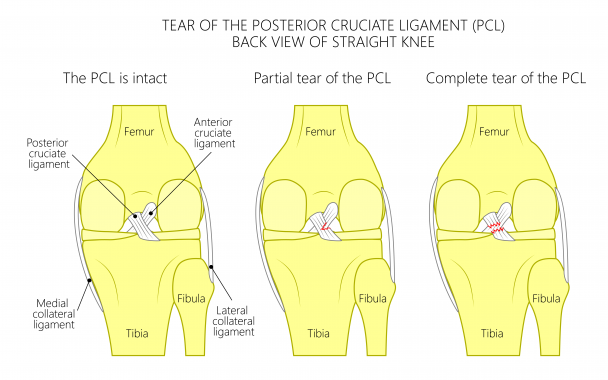
What is the Difference Between an ACL Sprain and Tear?
Leave a CommentACL injuries are one of the most recognized knee injuries that occurs in patients of all ages. Yet, there is often differences in the treatments and recovery of an ACL injury. While many factors may influence the recovery process, one significant factor is determining if the ACL is sprained or torn. So you might be wondering; what’s the difference between an ACL sprain and tear?
What is the ACL?
First, it may be helpful to review what the ACL actually is. The anterior cruciate ligament (ACL) is a ligament that connects your shin bone (the tibia) with your thigh bone (the femur). The ACL is located near the center of your knee and creates an X formation with your posterior cruciate ligament (PCL). The ACL provides stability to your knee by controlling forward movement of your shin bone along with rotational movements at the knee. The ACL is an important ligament in providing stability of the knee during dynamic movements, particularly with cutting, jumping, decelerating or twisting motions.
ACL Sprain Vs. Tear
A typical ACL injury occurs when the knee buckles in toward the middle, can possibly be associated with a popping sound, and frequently occurs during a non-contact activity. When an ACL injury is suspected, there are two main ways this injury is assessed.
First, a physical examination can be performed using several manual tests to assess the integrity of the ACL. A positive test is noted when the ligament does not seem to be preventing the motion it is designed to. The presence of swelling and loss of range of motion (ROM) may be noted. A thorough history of how the injury occurred all provide useful information. Using all the information gained the clinician is able to determine if an ACL injury is suspected. However, this may not always provide clear answers and further testing may need to be done.
An MRI is able to provide a picture of the ACL and is extremely useful in determining if the ACL has sustained an injury and if so to what extent. This is particularly important for our topic at hand, because the difference between an ACL sprain and an ACL tear is the extent to which the ligament has been injured.
There is a standard grading system used to classify the extent of an ACL injury:
- Grades 1 Mild Ligament Tear: There is minimal microscopic tearing to the ACL, but the ACL remains intact.
- Grade 2 Moderate Ligament Tear: There is a moderate amount of tearing to the ACL, but again the ACL remain intact.
- Grade 3 Torn or Ruptured Ligament: The ligament has torn in a manner that the ligament is only partially intact or is no longer intact at all.
Therefore, an ACL sprain is a Grade 1 or 2 injury to the ACL. The ligament has sustained some minor to moderate tearing, but the ligament has remained intact and can still perform its designed function. An ACL tear is when the ligament has partially or fully torn and can no longer perform its designed function.
Treatment Options
Treatment options may vary depending on if the ligament was a grade 1, 2 or 3 injury, however, some generally guidelines can be outlined.
- Physical Therapy: Typically is performed for those who have sustained an ACL sprain (Grades 1 or 2). Treatment may include ROM exercises, and focuses on decreasing swelling, increasing quad and hamstring strength, and normalizing functional movements such as walking, squatting and stairs. The patient may be able to return to their pre-injury ability with an ACL sprain without surgical intervention.
- Surgery: This option is determined by the treating physician, but is often a treatment option for Grade 3 injuries or unstable sprains. Because the ACL lacks a blood supply and cannot heal on its own, surgery involves reconstructing the ACL ligament, using a patient’s own tissue or a cadaver tissue, in order to reestablish stability to the knee. Physical therapy is then performed to restore function of the knee.
ACL Injury Prevention
To reduce the number of ACL injuries and improve the outcomes for athletes that suffer an injury, Athletico Physical Therapy offers the ACL 3P Program, which stands for Prevention, Progression and Performance. Although it is impossible to prevent all injuries, Athletico’s ACL 3P program can help athletes be confident in the steps they have taken to reduce the risk of injury so that they can stay in the game.
If you are interested in learning more about Athletico’s ACL 3P Program, including ACL risk assessment, please email ACL@athletico.com.
The Athletico blog is an educational resource written by Athletico employees. Athletico bloggers are licensed professionals who abide by the code of ethics outlined by their respective professional associations. The content published in blog posts represents the opinion of the individual author based on their expertise and experience. The content provided in this blog is for informational purposes only, does not constitute medical advice and should not be relied on for making personal health decisions.

